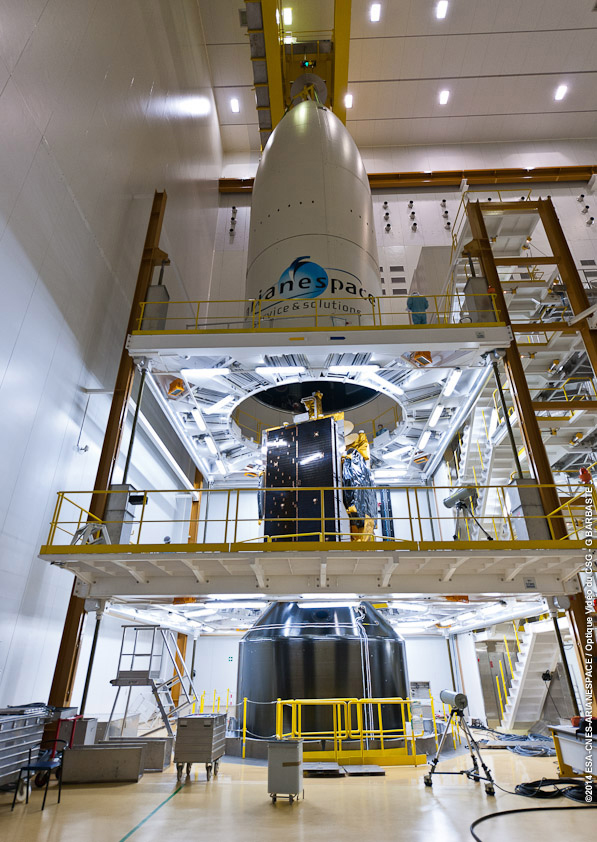
For the fourth time in 2014, Arianespace is readying one of its mammoth Ariane 5 boosters to deliver a heavyweight payload into orbit. After numerous delays, Mission VA-218—the 75th flight by an Ariane 5 and the 219th overall flight by a member of Arianespace’s rocket family—will roar aloft from the ELA-3 (Ensemble de Lancement Ariane) launch zone at the Guiana Space Centre in Kourou, French Guiana, on the evening of Thursday, 11 September. The launch “window” reportedly extends for 62 minutes, from 6:21 p.m. until 7:23 p.m. GFT (5:21 p.m. until 6:23 p.m. EDT). Primary payloads for the VA-218 mission are a pair of geostationary communications satellites: Measat-3B to provide coverage of Malaysia, India, and Indonesia and Optus-10 to cover Australia and New Zealand.
This flight has been waiting in the wings for several months, having originally been scheduled to fly on 28 May 2014. The “cryotechnic main stage” for VA-218’s Ariane 5 vehicle arrived at the Guiana Space Centre—which lies on the North Atlantic coast of the tiny French overseas region of French Guiana—early in January. It was delivered to Kourou’s Pariacabo Port aboard the MN Toucan, one of two sea-going vessels which provide “roll-on/roll-off” deliveries of Arianespace launch hardware between Europe and South America. It was then transported by road truck to the spaceport.
By mid-March, the 100-foot-tall (30-meter) cryotechnic main stage had been removed from its protective shipping container and installed onto the operational launch table in the Launcher Integration Building (BIL). This was followed by the attachment of Ariane 5’s twin solid-fueled boosters, the cryogenic upper stage, and the Vehicle Equipment Bay (VEB), which contains its computerized “brain.” A few weeks later, in mid-April, the VA-218 stack was transferred from the BIL to the Final Assembly Building (BAF). As well as a physical transfer, this movement marked the transfer of responsibility for the vehicle from prime contractor Airbus Defence and Space to Arianespace.
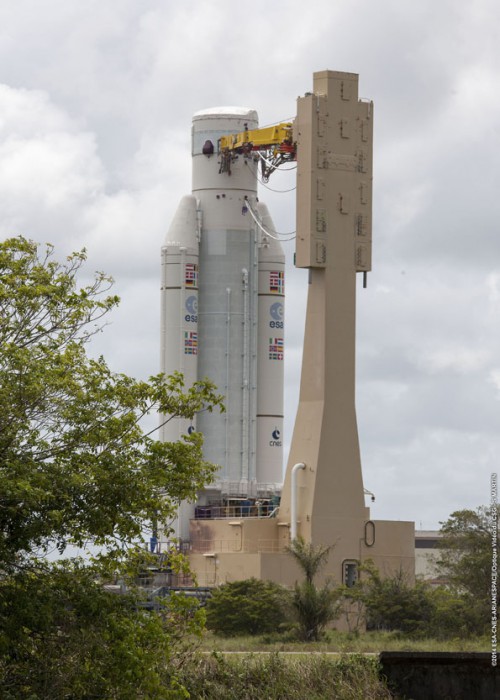
In the meantime, the Measat-3B communications satellite was delivered from prime contractor Airbus Defence and Space in Toulouse, France, to Félix Eboué International Airport, near the French Guianese capital, Cayenne, aboard a chartered An-124 cargo jetliner on 14 April. Fueling of the satellite with attitude-control propellants got underway in late April, and on 15 May it was installed onto the upper “deck” of the two-tiered Système de Lancement Double Ariane (SYLDA) payload dispenser. The lower deck was to be occupied by Optus-10, which had arrived in French Guiana in late April.
However, at this point it became apparent that the mission would slip from 28 May until no earlier than the second week of June, due to a serious thruster issue with Optus-10 which ultimately led it to be returned to the United States for rework and forced a correspondingly lengthy delay. “The liftoff of … Flight VA-218 has been postponed to enable verifications on one of the mission’s two satellite payloads, Optus-10,” Arianespace reported on 26 May. “A new launch date for this heavy-lift Ariane 5 mission will be announced as soon as possible.”
It soon became clear that the launch would not take place before September, and, in anticipation of this delay, Measat-3B was placed into storage and the VA-218 stack was returned to the BIL. In the meantime, Mission VA-219—carrying the fifth and final Automated Transfer Vehicle (ATV-5) cargo craft for the International Space Station (ISS)—flew successfully on 29 July. Three weeks later, an Arianespace Soyuz-Fregat booster launched the first pair of Galileo Full Operational Capability (FOC-1) satellites, although an upper stage malfunction left them in an improper orbit and their future remains unclear.
By the time of the Galileo launch, preparations for VA-218 had restarted in earnest. On 12 August the Ariane 5 stack was returned to the BAF, and on the 13th Optus-10 arrived at Félix Eboué International Airport aboard an An-124. Two weeks later, it completed its mandatory fit-check and was fueled, preparatory to integration into the lower deck of the SYLDA. With both satellites fully loaded, the total payload weight of VA-218 is estimated at 22,240 pounds (10,088 kg). With Measat-3B riding the upper deck, the ogive-shaped payload fairing was installed over the two satellites, and on 4 September Arianespace announced that after a long road the VA-218 stack was complete and ready for functional testing, the Flight Readiness Review on 9 September, and rollout to the ELA-3 zone on 10 September, in anticipation of an opening launch attempt on the evening of 11 September.
Mission VA-218 will mark the 75th flight by an Ariane 5, which first flew in June 1996, and the 219th overall flight by a member of Arianespace’s rocket family, since the maiden voyage of an Ariane 1 in December 1979. To date, it has proven an exceptionally reliable vehicle, having enjoyed 70 wholly successful missions. Only two have failed outright and two others have been classified as partial failures. On its first launch in June 1996, the Ariane 5 succumbed to a control software malfunction, which caused it to veer from its intended flight path and the Flight Termination System (FTS) remotely destroyed the vehicle. Its second launch, in October 1997, fared little better, suffering a premature shutdown of its core stage and failing to achieve orbit. Two others, in July 2001 and December 2002, also underperformed, but Ariane 5 has maintained an unblemished record ever since.
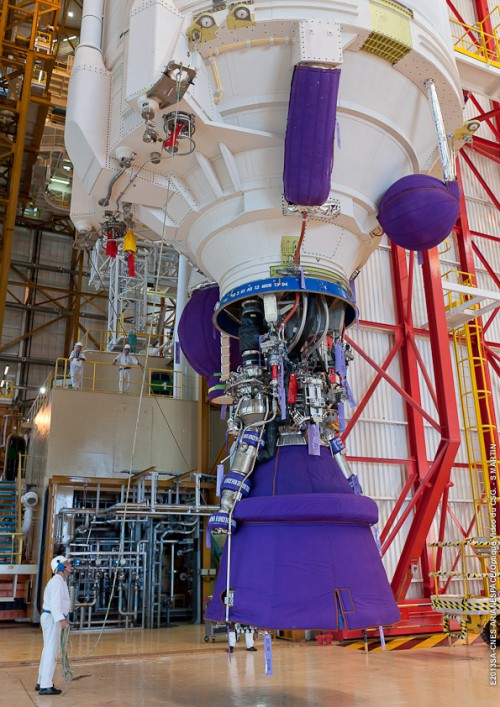
Thursday’s launch of Measat-3B and Optus-10 marks the fourth Ariane 5 mission of 2014, coming on the heels of VA-217 in February, which delivered the Athena-Fidus and ABS-2 satellites, VA-216 in March, which lofted Astra 5B and Amazonas 4A, and VA-219 in July, which delivered ATV-5. Putting this into context, the maximum number of Ariane 5 vehicles launched in a single calendar year has been seven, achieved in 2009 and 2012, with most other years averaging between four and six.
Final preparations for Thursday night’s launch are now underway, with the Launch Readiness Review on Tuesday providing authorization to proceed with Wednesday’s rollout of the 171-foot-tall (52-meter) VA-218 vehicle from the BAF to the ELA-3 launch zone. Upon arrival at the pad, Arianespace engineers will set to work establishing electrical, fluid, and other connections between the booster and ground facilities.
The process of loading 260,000 pounds (118,000 kg) of liquid oxygen and 50,000 pounds (22,700 kg) of liquid hydrogen to power the French-built Vulcain-2 engine of the first stage will get underway at T-4 hours and 50 minutes. The propellant tanks will be pressurized for flight at T-4 minutes, and the vehicle will transfer to internal power. In the final seconds, systems aboard Ariane 5 will assume primary command of all critical functions and the guidance system will be unlocked to Flight Mode. The Vulcain-2 will roar to life at T-0, producing 300,000 pounds (136,000 kg) of thrust, although liftoff will not occur for another 7.5 seconds, as a series of computer-controlled health checks are conducted. When all is verified to be well, the twin solid-fueled boosters—each punching out 1.4 million pounds (635,000 kg) of propulsive yield and together generating 92 percent of the thrust needed to get Ariane 5 off the pad—will ignite and VA-218 will be committed to its mission.
The stack will rise vertically for about five seconds, after which the two computers inside the VEB will initiate a combined pitch and roll program maneuver, actively rotating the vehicle onto a north-easterly trajectory and placing it onto the correct flight azimuth to insert ATV-5 into a 51.63-degree-inclined orbit. One minute into the ascent, the vehicle will go supersonic and pass “Max Q,” the period of maximum aerodynamic stress on the airframe. The twin boosters will be jettisoned at T+142 seconds, parachuting into the Atlantic Ocean about 300 miles (480 km) east of Kourou. Meanwhile, Ariane 5 will by now have reached a velocity of over 1,200 mph (1,900 km/h) and will continue to climb under the impulse of its Vulcain-2 engine.
Three and a half minutes into the flight, the bullet-like payload shroud will be detached, exposing the Measat-3B and Optus-10 satellites to the space environment for the first time. Shutdown of the Vulcain-2 is expected about eight minutes and 56 seconds after launch, whereupon the cryotechnic main stage will descend to a splashdown off the coast of Portugal. Meanwhile, the second stage—powered by a restartable, 6,100-pound-thrust (2,770-kg) Aestus engine—will ignite to pick up the baton for the final push into orbit. By now, the rocket will be over 105 miles (170 km) high and traveling at more than 4,300 mph (6,900 km/h). Its progress during this period will be tracked by stations at Ascension Island in the mid-Atlantic, Libreville in Gabon, and Malindi on the Indian Ocean coast of Kenya.
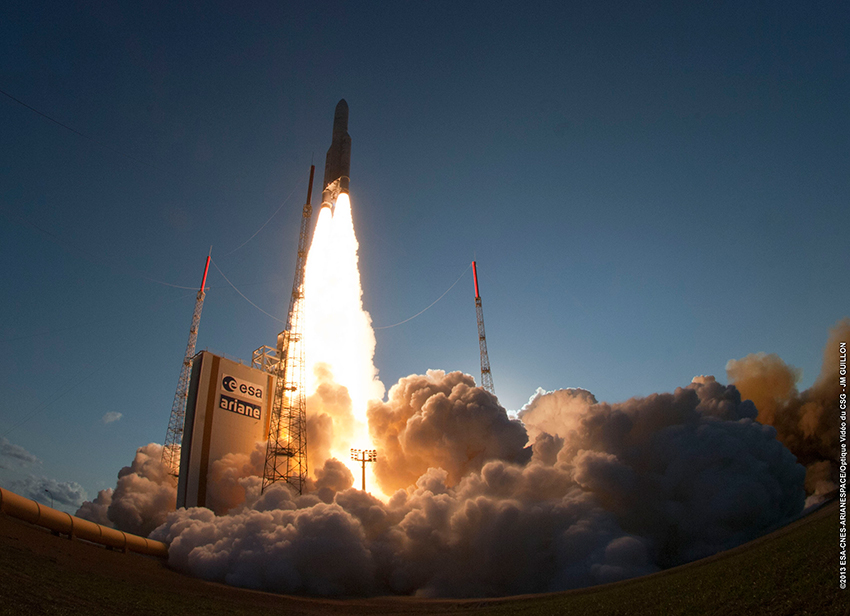
Fueled with unsymmetrical dimethyl hydrazine and nitrogen tetroxide, the Aestus will burn for about 16 minutes, shutting down 25 minutes and 13 seconds after leaving French Guiana. Upon orbital injection, the VA-218 stack will have attained a velocity of about 20,926 mph (33,678 km/h) and an altitude of about 406.8 miles (654.7 km). With Measat-3B mounted on the upper deck of the SYLDA payload dispenser, it will be released into space first, at T+26 minutes and 54 seconds. The SYLDA will separate and Optus-10 will itself be released from the lower deck at T+34 minutes and 26 seconds. Following standard collision-avoidance maneuvers, the VA-218 mission will officially end at T+47 minutes.
Built by Airbus Defence and Space, the 13,000-pound (5,900-kg) Measat-3B will be positioned at 91.5 degrees East longitude—co-located with the 2006-launched Measat-3 and 2009-launched Measat-3A satellites—to provide a robust Asian telecommunications and Direct-to-Home (DTH) satellite broadcasting “neighborhood.” Measat-3B is three-axis-stabilized, with two solar array “wings,” and measures 21.6 feet (6.6 meters) x 9.2 feet (2.8 meters) x 7.5 feet (2.3 meters) and is designed for an operational lifetime of 15 years. Based upon Astrium’s Eurostar-3000 satellite “bus,” it provides 48 Ku-band transponders and offers large capacity and coverage of Malaysia, India, and Indonesia. Several of its transponders are also expected to be leased to Australian operator NewSat Ltd.
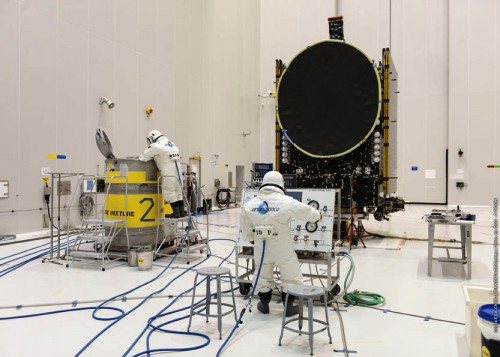
The Malaysia-based Measat operator was originally founded in 1993 as Binariang Satellite Systems, before being renamed “Measat” for “Malaysia East Asia Satellite.” The Measat-1 and Measat-2 geostationary satellites were launched via Ariane 4 vehicles from the Guiana Space Centre in January and November 1996, respectively, followed by Measat-3 atop a Proton-M/Briz-M booster from Baikonur in December 2006. Next came the Measat-3A satellite, delivered from Baikonur into geostationary orbit by a Land Launch Zenit in June 2009. Measat-3B represents the largest and most powerful communications satellite ever ordered by Measat.
The second satellite aboard Mission VA-218, Optus-10, was built by Space Systems/Loral (SS/L) and weighs 7,200 pounds (3,270 kg). Like Measat-3B, it is a three-axis-stabilized platform, with twin solar array “wings,” measures 16.7 feet (5.1 meters) x 10.2 feet (3.1 meters) x 10.2 feet (3.1 meters) and carries 24 Ku-band transponders. Positioned at 164 degrees East longitude, Optus-10 will operate for 15 years and will provide coverage of Australia, New Zealand, and as far south as Antarctica. It is operated by the Australia-based Optus telecommunications organization and is the latest in an expansive system of satellites, which are divided into four discrete classes (A through D).
The three-strong Optus “A” class were all former Aussat communications satellites, the first of which was delivered into orbit by the crew of shuttle mission 51I in August 1985, and all are now retired. The trio of “B” generation satellites, the first of which was launched in August 1992, included the ill-fated Optus-B2, lost in a launch failure. The Optus-C1 satellite was placed into orbit in June 2003, followed by the “D” generation platforms in October 2006, October 2007, and August 2009. All three of the Optus-D satellites were delivered into orbit by Ariane 5 boosters.
Want to keep up-to-date with all things space? Be sure to “Like” AmericaSpace on Facebook and follow us on Twitter: @AmericaSpace



